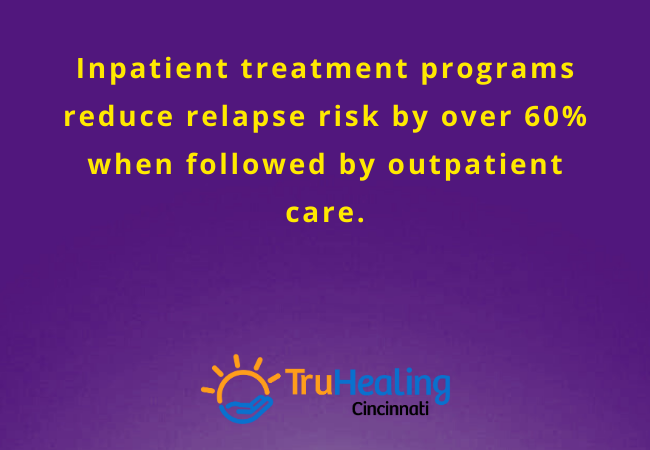When you decide to seek treatment for addiction, you’re already making one of the most courageous choices of your life. But as you take this brave step toward recovery, an important question arises: Should you choose inpatient or outpatient treatment?
For anyone searching for Cincinnati addiction treatment, understanding the differences between inpatient and outpatient care is critical. It’s not just about the setting — it’s about finding the program that best supports your individual needs, your lifestyle, your level of addiction, and your personal goals for recovery.
At TruHealing Cincinnati, we specialize in personalized, compassionate care. Whether you’re considering immersive inpatient care at one of the many trusted rehab centers in Cincinnati, or the flexibility of outpatient treatment in Cincinnati, this guide will help you make an informed, confident decision.
Understanding the Difference: Inpatient vs. Outpatient Addiction Treatment
Let’s start with the basics.
What Is Inpatient Treatment?
Inpatient (or residential) addiction treatment means you live full-time at a treatment center while receiving intensive medical and therapeutic care. This environment is highly structured and designed to help you focus 100% on your recovery, away from everyday distractions and triggers.
At inpatient rehab centers in Cincinnati, you can expect:
- 24/7 medical monitoring and emotional support
- Supervised detox and withdrawal management
- Daily individual and group therapy sessions
- Activities like fitness, meditation, and art therapy
- Meals, housing, and all-inclusive care
This is ideal for:
- Severe or long-standing addictions
- Co-occurring mental health challenges
- Unstable or triggering home environments
- Those at risk of medical complications during detox
What Is Outpatient Treatment?
Outpatient addiction treatment allows you to live at home and continue with daily life responsibilities, while still receiving professional support.
Outpatient options at TruHealing Cincinnati include:
- Partial Hospitalization Treatment in Cincinnati (PHP):
Intensive treatment for 5–6 hours a day, typically 5 days a week. - Intensive Outpatient Treatment In Cincinnati (IOP):
Moderate intensity care for 3–4 days a week, perfect for ongoing support. - Standard Outpatient Care:
Weekly sessions for maintenance and relapse prevention.
Outpatient is best for:
- Mild to moderate substance use disorders
- Those with a stable, supportive home life
- People transitioning from inpatient care
- Individuals balancing recovery with work or family life
Why Does the Choice Matter?
Choosing between inpatient and outpatient addiction treatment is not just a logistical decision — it’s a life-shaping choice.
Your success in recovery is deeply connected to the right level of care at the right time.
At TruHealing Cincinnati, we guide you through this decision with compassionate assessments, considering:
- The severity and history of your addiction
- Physical health and risk of withdrawal complications
- Co-occurring mental health conditions
- Daily responsibilities like work, school, or family
- Support systems at home and in your community
By understanding your unique circumstances, we can recommend a care path that maximizes your chances of long-term success.
Deep Dive: Inpatient Treatment in Cincinnati
Let’s explore what inpatient care looks like in detail.
1. Safe, Supervised Detox
Detox can be dangerous if done alone. Inpatient programs provide medical detox services for safe withdrawal management — especially critical for opioid addiction treatment in Cincinnati.
2. 24/7 Support and Supervision
Cravings and emotional swings can strike at any time. Inpatient care ensures you have immediate support whenever you need it.
3. Immersive Therapy
You’ll participate in:
- Daily one-on-one counseling
- Group therapy for peer support
- Family therapy (where appropriate)
- Trauma-informed care and dual diagnosis treatment
4. Focused Environment
Without everyday triggers, you can devote all your energy to healing.
5. Strong Recovery Community
Living alongside others who understand your journey builds powerful, lasting connections.
Bonus: Who Thrives in Inpatient Care?
- Individuals facing severe opioid or alcohol addiction
- People with multiple relapses
- Those with co-occurring mental health disorders like PTSD, anxiety, or depression
- Anyone who lacks a safe, stable home environment
Deep Dive: Outpatient Treatment in Cincinnati
Outpatient treatment provides the same quality of care — therapy, counseling, and peer support — but with the flexibility to live at home.
1. Maintain Daily Responsibilities
Outpatient care empowers you to:
- Continue working
- Attend school
- Care for children or loved ones
2. Flexible Scheduling
Outpatient services like IOP or PHP offer varied schedules to fit your life.
3. Cost-Effective
Outpatient programs are generally more affordable than inpatient care and often covered by insurance.
4. Step-Down Support
Outpatient care serves as a crucial next step after inpatient rehab, providing ongoing accountability.
5. Real-World Application
You’ll practice coping skills and recovery strategies in your everyday life, with professional support just a phone call away.
Bonus: Who Thrives in Outpatient Care?
- Individuals with mild to moderate substance use disorders
- People transitioning from inpatient care
- Those with strong support systems at home
- Anyone seeking flexibility while maintaining recovery
Partial Hospitalization and IOP: The Middle Ground
You don’t always have to choose strictly inpatient or outpatient.
At TruHealing Cincinnati, we offer Partial Hospitalization Treatment in Cincinnati (PHP) and Intensive Outpatient Treatment In Cincinnati (IOP) as bridge programs.
Partial Hospitalization (PHP):
- 5–6 days per week of structured care
- Daily therapy and medication management
- Ideal for those needing substantial support post-detox
Intensive Outpatient Program (IOP):
- 3–4 days a week, several hours per day
- Flexible, while still offering robust support
- Perfect for balancing work, family, and recovery
These programs allow you to transition gradually, keeping you connected to care while you build independence.
Factors to Consider When Choosing Between Inpatient and Outpatient
When choosing your path, ask yourself:
- What is the severity of my addiction?
- Do I have safe, sober support at home?
- Have I tried treatment before?
- Am I facing mental health challenges alongside addiction?
- What commitments do I need to maintain?
- Am I ready to practice recovery skills in daily life, or do I need more structure first?
At TruHealing Cincinnati, our admissions specialists are here to help you answer these questions honestly and compassionately. We’ll help you build a plan that feels right for you.
Success Rates: Inpatient vs. Outpatient Treatment
Inpatient Success Stats:
- Inpatient programs reduce relapse risk by over 60% when followed by outpatient care. (SAMHSA, 2024)
- Medically supervised detox at inpatient facilities lowers the risk of dangerous withdrawal complications.
Outpatient Success Stats:
- Outpatient treatment paired with therapy doubles the likelihood of long-term recovery. (Harvard Medical School, 2024)
- People who complete IOP have similar success rates to inpatient care, provided they have strong community and family support.
Key Takeaway:
The real secret to success is continuity of care. Detox, therapy, outpatient support, and ongoing aftercare together create the best outcomes.
How TruHealing Cincinnati Supports Your Entire Recovery Journey
At TruHealing Cincinnati, you’re never alone in your recovery.
No matter where you start — inpatient or outpatient — we’ll be your partner every step of the way.
Our full range of services includes:
- Safe detox referrals
- Medication-Assisted Treatment (MAT)
- Partial Hospitalization Program (PHP)
- Intensive Outpatient Program (IOP)
- Standard outpatient care
- Dual diagnosis mental health support
- Life skills and relapse prevention
- Ongoing alumni support and aftercare
We design your care plan around your unique goals, giving you the best chance at lasting sobriety.
Conclusion
Both inpatient and outpatient addiction treatments in Cincinnati offer powerful pathways to healing. What matters most is finding the right fit for your needs, your lifestyle, and your stage of recovery.
At TruHealing Cincinnati, we believe recovery is not about choosing one path over another — it’s about choosing to move forward, no matter where you start. Call us today at 513.643.9118. Let’s have an honest conversation about your options and build a personalized plan for your future. Your journey to recovery starts with one brave choice — and we’ll walk every step of it with you.
FAQ on Inpatient and Outpatient Treatment
What is the main difference between inpatient and outpatient treatment?
Inpatient treatment involves living at a facility full-time, offering 24/7 care. Outpatient treatment allows you to live at home while attending therapy and support sessions at rehab centers in Cincinnati.
How do I know if I need inpatient treatment in Cincinnati?
Inpatient care is ideal if you have severe addiction, co-occurring mental health conditions, or lack a stable, supportive home environment. It offers intensive, round-the-clock support for recovery.
Can outpatient treatment work for opioid addiction?
Yes! Outpatient programs like Intensive Outpatient Treatment in Cincinnati and Partial Hospitalization Treatment in Cincinnati offer strong support, especially when combined with Medication-Assisted Treatment (MAT).
Is outpatient rehab more affordable than inpatient?
Generally, yes. Outpatient treatment in Cincinnati is typically more cost-effective because it doesn’t include room and board, and many insurance plans cover outpatient services.
What is Partial Hospitalization Program (PHP)?
Partial Hospitalization Treatment in Cincinnati provides structured, intensive treatment during the day while allowing you to return home at night. It’s a great middle ground between inpatient and outpatient care.
Can I transition from inpatient to outpatient care?
Absolutely. Many people begin with inpatient care and step down to Intensive Outpatient Treatment in Cincinnati or outpatient programs for ongoing support as they build independence.


